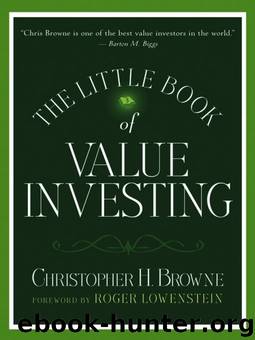The Little Book of Value Investing by Browne Christopher H. & Lowenstein Roger

Author:Browne, Christopher H. & Lowenstein, Roger
Language: eng
Format: epub
Publisher: Wiley
Published: 2010-05-24T16:00:00+00:00
Chapter Twelve
Give the Company a Physical
A thorough checkup will help
avoid investing mistakes.
NOW THAT WE HAVE A LIST of candidates and have determined the reasons the stock is cheap, it is time to figure out what the company is actually worth. Start by examining the balance sheet. Much as a doctor consults patients’ charts to see what condition they are in, look to the balance sheet to see what shape the company is in. The doctor needs to know all the vital signs to make a diagnosis. A balance sheet is effectively a company’s medical chart, a snapshot of its financial condition at a given point in time. It shows how solvent the company is and exactly what shape—good or bad—it is in. Here is where you begin to develop a better idea of what the company is actually worth, how much it owes, and what resources it has to survive going forward. The balance sheets show what assets can be quickly converted to cash, and what fixed assets like factories and equipment are owned. The balance sheet also tells how much money the company owes and its net worth. It is basically the same form you fill out when you apply for a loan.
One of the most important aspects of the balance sheet is liquidity. Liquidity is the amount of cash the company can lay its hands on in the short term. Liquidity provides the flexibility to withstand down cycles in the economy, pay dividends to shareholders, buy back stock, and take advantage of future opportunities. You also want to make sure that the company is not overly burdened with debt, and that there is enough capital to stay in business during bad times.
The first place to look on the balance sheet is the category of current assets. Here the company lists all its cash and assets that can be turned into cash in a relatively short period such as a year or less. This includes short-term investments such as T-bills, inventories that are finished products ready for sale or products that are in the process of being manufactured, and receivables from customers who have bought their products.
Next is the current liabilities section of the balance sheet. As current assets are assets that can generally be converted to cash in a year or less, current liabilities are debts that fall due within a year or less. They include such items as interest payments on the company borrowings and accounts payable to the company’s suppliers, as well as taxes owed but not yet paid. Dividing current liabilities into current assets gives us an important ratio in balance sheet analysis, the current ratio. This ratio reveals a company’s ability to pay its short-term obligations. A rough rule of thumb is a ratio of two to one, that is, the company has twice the amount of liquid assets as it has short-term debts and obligations. This can vary depending on the business, but I like to err on the conservative side. It is also helpful to compare this number to other companies in the same industry.
Download
This site does not store any files on its server. We only index and link to content provided by other sites. Please contact the content providers to delete copyright contents if any and email us, we'll remove relevant links or contents immediately.
| Analysis & Strategy | Bonds |
| Commodities | Derivatives |
| Futures | Introduction |
| Mutual Funds | Online Trading |
| Options | Portfolio Management |
| Real Estate | Stocks |
Rich Dad Poor Dad by Robert T. Kiyosaki(6414)
Pioneering Portfolio Management by David F. Swensen(6230)
How To Win Friends and Influence People by Dale Carnegie(4447)
The Money Culture by Michael Lewis(4083)
The Dhandho Investor by Mohnish Pabrai(3706)
The Wisdom of Finance by Mihir Desai(3659)
Liar's Poker by Michael Lewis(3372)
Fooled by Randomness: The Hidden Role of Chance in Life and in the Markets by Nassim Nicholas Taleb(3049)
The ONE Thing by Gary Keller(3013)
The Intelligent Investor by Benjamin Graham Jason Zweig(2995)
Mastering Bitcoin: Programming the Open Blockchain by Andreas M. Antonopoulos(2983)
Rich Dad Poor Dad: What The Rich Teach Their Kids About Money - That The Poor And Middle Class Do Not! by Robert T. Kiyosaki(2910)
How to Day Trade for a Living: Tools, Tactics, Money Management, Discipline and Trading Psychology by Andrew Aziz(2909)
Investing For Dummies by Eric Tyson(2895)
How to Win Friends and Influence People by Dale Carnegie(2864)
Market Wizards by Jack D. Schwager(2645)
The Psychology of Money by Morgan Housel(2634)
Zero Hour by Harry S. Dent Jr. & Andrew Pancholi(2614)
How to Pay Zero Taxes, 2018 by Jeff A. Schnepper(2604)
